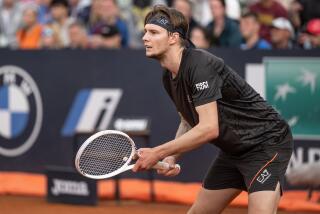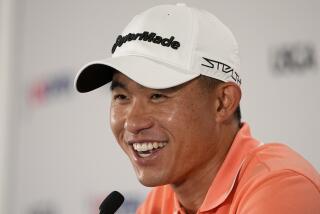Speeding Along : At 20, Pete Sampras’ Toughest Challenge May Be Keeping Up With Predictions of Glory
- Share via
NEW YORK — There is no pressure on Pete Sampras.
(Who hits a serve with the trajectory of a clothesline, has a net game so hot it should be called Death Volley, had a Grand Slam title before he had a girlfriend, and is the favorite of no less than Don Budge, Ellsworth Vines, Jack Kramer and Fred Perry.)
There is no pressure on Pete Sampras.
(Who banked more than $5 million last year in prize money, endorsements and guarantees, won $2 million of that at a single tournament and soon risks the potential of millions more.)
There is no pressure on Pete Sampras.
(Who had injuries to his legs, hamstring, ankle and wrist, causing him to worry that he might be falling apart piece by piece and fret about what his physical condition might be at the ripe old age of 25.)
The truth is, there’s enough pressure on Sampras that you could spread it with a snowplow. And now it’s that time of year again for Sampras, the reigning U.S. Open champion, who is back where the whole thing began for him, 50 weeks ago.
Only 28 days past his 19th birthday, Sampras became the youngest U.S. Open men’s singles champion with an incandescent tennis game that lit up the dirty gray sky above Flushing Meadow and raised expectations to just about the same height.
He concluded an improbable two-week demolition of the Who’s Who in World Tennis--knocking off in succession Thomas Muster, Ivan Lendl and John McEnroe--with his most convincing victory of all, a 6-4, 6-3, 6-2 obliteration of Andre Agassi in only 1 hour and 42 minutes.
What happened then, Sampras supposes, was just his destiny.
“You really can’t explain it,” he said. “I guess it’s just the way it happens. I just got swept along.”
Already he has said goodby to his teen-age years, jumped straight into the biggest pressure-cooker of his tennis career and tried to make sense of one strange 12-month period.
For Sampras, the task has been a difficult one, tougher than Lendl’s steely resolve, McEnroe’s wits or Agassi’s hammered groundstrokes. All Sampras has to do is survive a head-on collision between rampant injuries and runaway expectations.
To his credit, Sampras has survived, even though he hasn’t exactly thrived. He slogged through a less-than-average first half of the year, which included disappointing second-round losses at both the French Open and Wimbledon, but seems to be coming on of late.
“I really didn’t have any doubts about myself, although maybe other people did,” Sampras said. “I know I am a good player.”
He won the Volvo/Los Angeles tournament the first week of August, beating Stefan Edberg in the final. The next week, he made it to the final of the ATP Championship in Cincinnati, losing to Guy Forget, then knocked off Boris Becker in the final of the U.S. Men’s Hardcourt tournament at Indianapolis.
During a season in which no one player has been able to dominate hardcourt tournaments, Sampras seems to be playing as well as anybody, by most accounts.
“He wasn’t playing that well before,” said Brad Gilbert, who lost to Sampras in the Volvo/Los Angeles final. “So I imagine he’s feeling a lot better about himself. Maybe he’s forgetting all the other stuff. This has got to help his confidence a lot.”
The mechanics of Sampras’ game have never really been questioned. Most who spend a lot of time watching him worry only if Sampras is going to stay focused--or uninjured--long enough.
Maybe Sampras’ body is past the growing pains period, but he is still capable of bursts of immaturity. There was a remarkable example recently at the end of the tournament in Los Angeles when, during the victory ceremony, he accepted the winner’s check from Volvo executive Bill Mergler, then embarrassed him.
Sampras took the microphone and said, “You’ve had a few drinks, haven’t you?”
Mergler tried to make a joke of the incident and later downplayed it, although he seemed to many to have been hurt.
Perhaps Sampras merely pulled a muscle in his head. If so, Sampras hasn’t had any other injuries of note since he twisted his ankle playing an exhibition against Agassi at Minneapolis in April. Sampras also hurt his wrist then, when he tried to break his fall.
The painful shin splints, which forced him out of the Australian Open in January, seem to have disappeared, thanks to a strict stretching regimen.
But the expectations haven’t exactly gone away. Stefan Edberg said Sampras ought to be the favorite in the U.S. Open.
“Why not?” Edberg said. “He played so well at the U.S. Open last year and continued to play quite well at the end of the year in Munich (where Sampras won $2 million in the $6-million Grand Slam Cup).
“Yes, he got some injuries and if you are out for injuries one, two or three times, you are going to lose a lot of ground,” Edberg said. “And he lost matches he shouldn’t have lost. But I think he has worked real, real hard.”
Budge leads a group of Sampras fans who dominated international tennis in the 1930s and ‘40s, a group that includes Vines, Kramer and Perry.
Budge, who won the Grand Slam in 1938, said Sampras is his choice to repeat as U.S. Open champion, regardless of the pressures.
“He has already gotten over the toughest hurdle, to win it the first time,” Budge said. “Until you’ve done it once, you don’t know. There’s always that doubt.
“When I won Wimbledon the first time (1937), I remember thinking, ‘Oh, boy, I won the first set, can I get two more?’ The next time was a piece of cake.
“After watching him beat Becker, he still plays the best way,” Budge said. “Becker still has this weakness on the forehand. He’s a good player, but not a great player. That ends it. Pete has all the shots to be a great player. Like Fred Perry said, you don’t even hear him going in to the net. He just seems to float in.
“My hat is off to him. I would still pick him over the U.S. Open field. When I saw him in Philadelphia earlier this year, I said, ‘Pete, you’re going to be the next player to win the Grand Slam (and) I’m rooting for you.’ ”
The usual Sampras cheering section is larger this year. Although Soterios (Sam) and Georgia Sampras seldom watch their son play, brother Gus is a constant traveling companion, along with Coach Joe Brandi.
But there is one more in the Sampras entourage, 26-year-old girlfriend DeLaina Mulcahy of Houston, who lives in Bradenton, Fla., as does Sampras.
Mulcahy accompanied Sampras to the Los Angeles event, but is not always at his side at tournaments. Brandi said that Mulcahy has not distracted Sampras, as some tennis experts have asserted.
“As far as his tennis, this relationship has helped because he’s more relaxed,” Brandi said.
What awaits Sampras at the U.S. Open hardly seems to qualify as a relaxing experience for its youngest champion. In the end, Sampras knows that what happens will depend largely on him, so he has decided to prepare himself in his own way.
“I haven’t asked anyone else how to defend a Grand Slam title and I won’t,” Sampras said. “I’m just going to ease my way in. I’m basically going to treat it like another tournament, although it obviously isn’t.
“What I’ve wanted to do, especially with all my injuries, is to play a lot of matches and be on a roll coming in,” he said. “Well, I feel like I’ve done that.
“I’m just going to see how it works out with me. I’m not trying to prove anything. Last year, well, sometimes I just can’t believe it. But I think I’ll appreciate it more later on in life because right now, everything is going so fast.”
More to Read
Go beyond the scoreboard
Get the latest on L.A.'s teams in the daily Sports Report newsletter.
You may occasionally receive promotional content from the Los Angeles Times.










